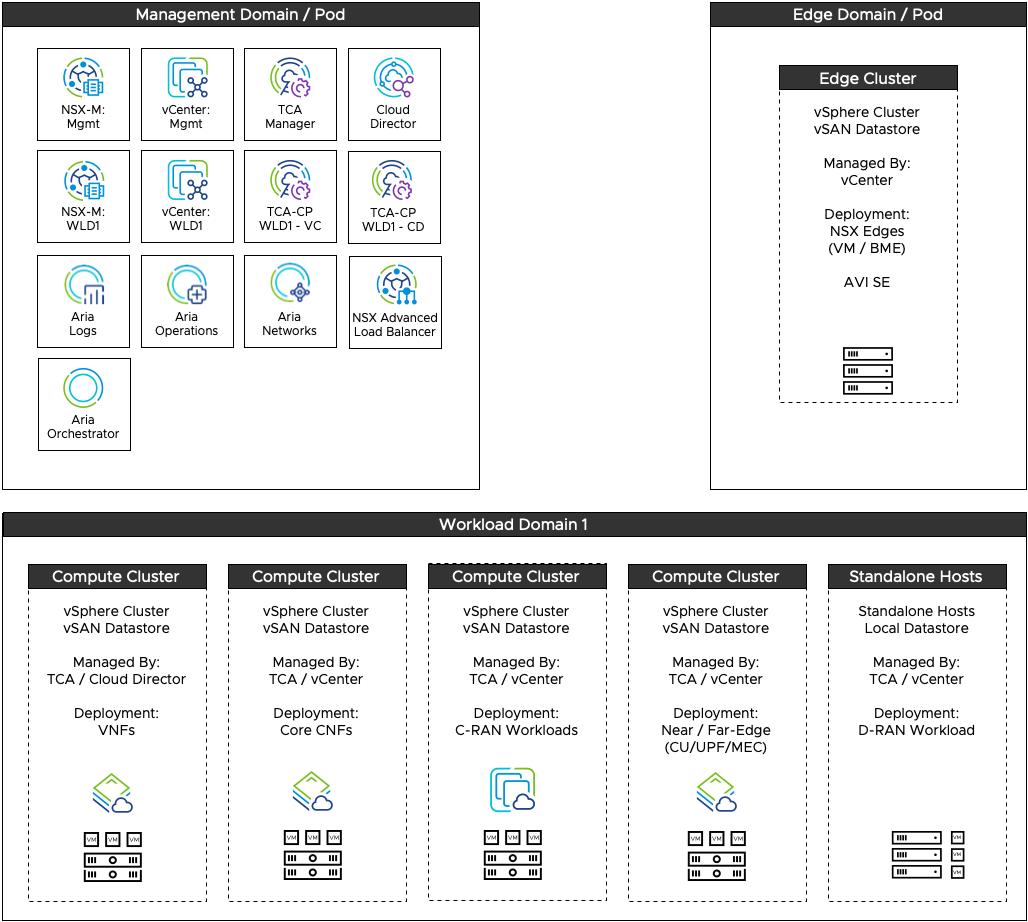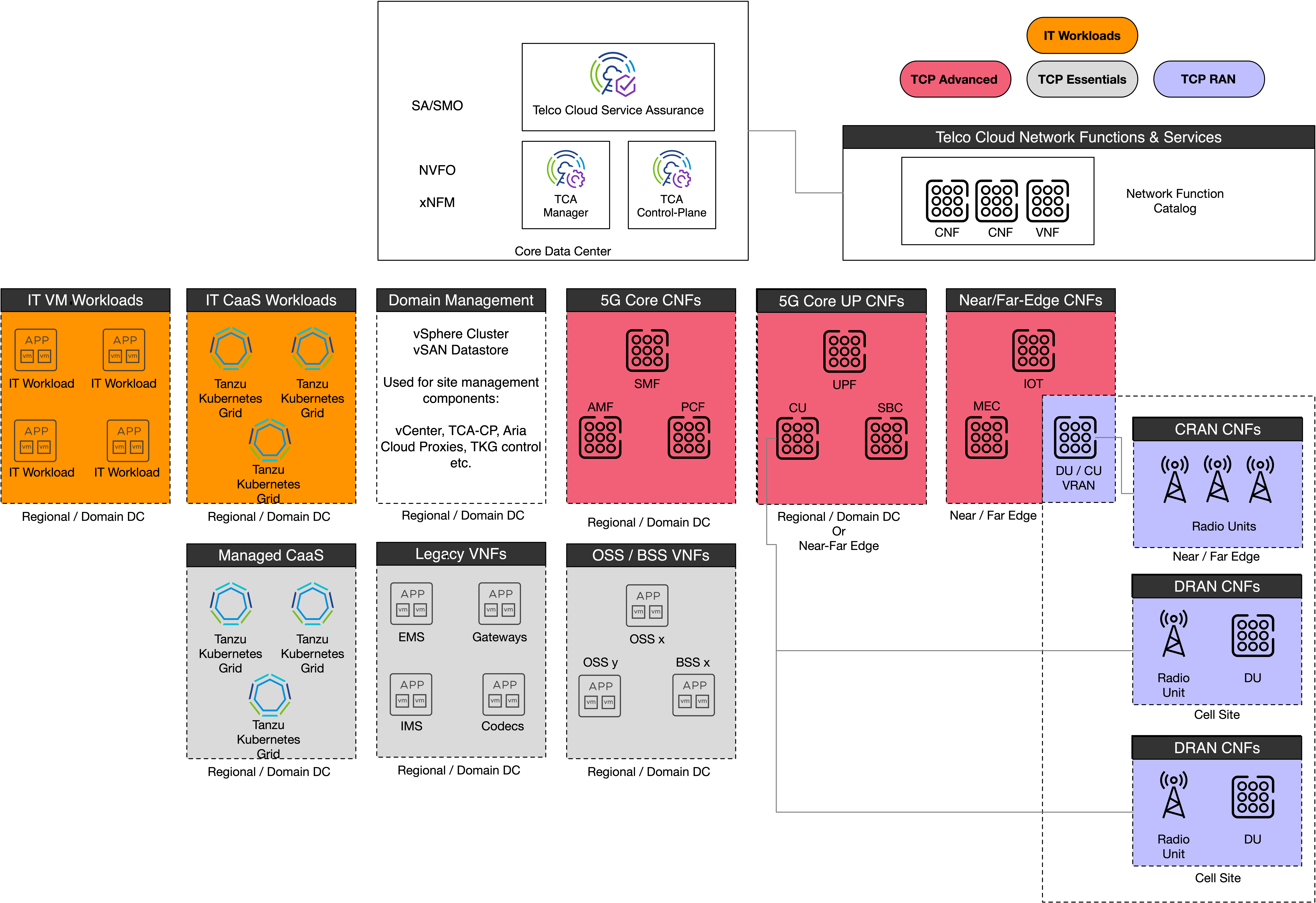This section describes the end-to-end deployment architecture of the Telco Cloud Platform, covering both centralized and multi-site designs. These deployment models encompass IaaS services for 4G/5G VNFs as well as 5G Core and RAN CNFs.
Centralized Deployment Model
In the Centralized deployment model, the Telco Cloud is divided into various domains. Each domain serves a specific purpose to the applications running on the Telco Cloud.
The Management pod or domain hosts all the components necessary for the instantiation and operation of the Telco Cloud. Each workload domain hosts one or more compute environments that allow the placement of workloads such as 4G VNFs, 5G Core, and RAN CNFs.
Depending on the overall use case and design requirements of the Telco Cloud, the Management domain components vary for each Telco Cloud deployment. For example, a RAN-only deployment does not require components such as NSX and VMware Cloud Director.
Depending on your requirements and the need for overlay networking in the management domain, you can build the management pod based on Telco Cloud Platform Essentials or Telco Cloud Platform Advanced.

In the management domain, a single vCenter manages each workload domain. The expansion of workload domains requires additional vCenter Servers and TCA-CP nodes.
A single management domain is deployed in the main data center (central data center). It can stretch across multiple data centers in an active-active or active-standby configuration leveraging the BCDR solution for management domain failover.
The telco cloud architecture can be scaled out and scaled up across the cloud, within a specific workload domain, or across multiple workload domains.
The telco cloud can be scaled out by adding more workload domains with a new vCenter Server, Telco Cloud Control Plane, and NSX deployments.
Note:When adding more workload domains, the Management domain may require additional resources for new vCenter, NSX, and Avi Load Balancer deployments.
NSX is available only when using Telco Cloud Platform Advanced.
A single workload domain can be scaled up by adding more compute clusters to be consumed by VMware Cloud Director or Telco Cloud Automation, and by adding more cell sites (standalone hosts) for RAN deployments.
Multi-Site Deployment Model
The multi-site deployment model of the telco cloud platform provides a distributed approach to the management pod such that the components can be distributed throughout the network. The central management domain can host the main components of the Telco Cloud. A localized, smaller management domain can be added to each site for independent site management.

The following components can be deployed in a localized management cluster within a distributed environment:
Local vCenter to manage the site resources
Local NSX or Avi Load Balancer to manage site networking
Local Telco Cloud Automation-Control Plane for site control
Local Aria Operations Cloud Proxies for remote data collection and forwarding to the central management domain
Local Aria Operations for Logs collectors for remote log collection and forwarding to the central management domain
Additional components can be deployed in the localized management domain based on the requirements for function distribution and locality of management.
Depending on your requirements, you can deploy the management domain (in a single-site or multi-site configuration) using either Telco Cloud Platform Essentials or Telco Cloud Platform Advanced.
In both the centralized and multi-site deployment designs, all workloads do not have to be on a single site. A workload domain can host multiple compute clusters or RAN nodes from multiple physical locations. The multi-site design applies the concept of workload distribution across multiple DCs to the management components as well.
The characteristics of a management domain in an end-to-end deployment architecture:
Each workload domain has its own vCenter hosted on the centralized or multi-site management domain.
Each workload domain has one or more TCA-CPs hosted on the centralized or multi-site management domain.
Each workload domain has its own NSX manager (if required and using Telco Cloud Platform Advanced).
Note: NSX is not required for a RAN workload only domain.
The VIM options must not share a single cluster. Separate clusters are recommended for VNFs, CNFs, or RAN workloads. Sharing a single cluster across multiple VIMs is not recommended. On a platform that has elements of Telco Cloud Platform Essentials, Advanced, and RAN, demarcate the clusters based on vCenter.
Different vSphere switches can be created for different clusters. The vSwitch architecture for RAN sites uses a different vSwitch design for 5G Core and VNF based clusters.
When using Tanzu Kubernetes Grid, deploy the control-plane nodes in the workload cluster. Alternately, the control-plane nodes can be deployed in a separate cluster that is part of the same vCenter.
A workload domain does not have to host all cluster types. Depending on the requirements, a workload domain may consist entirely of standalone hosts for RAN workloads (along with a near/far edge cluster for storing the control plane nodes) or the workload domain may consist of vSphere clusters for legacy VNF placement through Cloud Director.
Cross-Domain Management
Cross-Domain Management is an additional architecture that you can consider along with the centralized and distributed management domain. Cross-domain management includes a single management domain that covers multiple domains, such as the CSP Telco Cloud and the CSP private IT cloud.
The benefits of a cross-domain management strategy:
Reduced server count
Higher server utilization
Single pane-of-glass for Aria Observability
The concept of a cross-domain management strategy has specific requirements that must be considered when planning the management domain architecture.
RBAC within the management vCenter to determine which team (or virtual-team) is responsible for managing the cross-domain management cluster.
Role-Based access to Aria for Logs Deployment to ensure separation of IT and Telco Cloud Logs
Role-Based access to the Aria Operations Deployment, to ensure the separation of IT and Telco Cloud data collection, metrics, and alarms
The IT and Telco domains share a common foundational infrastructure, but the corresponding clouds operate independently. Hence, adhere to the following guidelines when using cross-domain management:
No shared vCenters. Each domain must have a dedicated vCenter. NSX managers from the appropriate domain must be connected to vCenter. vCenters from different domains must not leverage vCenter ELM.
No shared or stretched NSX deployments. Each domain must have a dedicated NSX. Compute managers must be added to NSX from within the same domain.
Use separate Cloud Director deployments (if used) for IT and Telco domains. Cloud Director deployments can be managed through the vCloud Provider LCM tool, provided that a team with common access is defined to manage the cross-domain management domain and its components.
Use separate Aria Automation and Aria Automation Orchestrator deployments for IT and Telco domains.
The separation of key components across the domains is to accommodate varying lifecycle cadences. Maintaining uniformity across both domains is ideal, but the lifecycle of these domains can vary due to different upgrade triggers. When components are shared, the lowest common demoninator takes precedence, stalling the lifecycle management process.
The following diagram illustrates different domains that can be managed from a centralized cross-domain management cloud. Both IT and Telco workloads are managed independently from a centralized management domain. The workload domains remain completely independent, with their dedicated vCenters, NSX Managers, and hardware. The only shared element in this scenario is the Aria Core observability components (Aria Operations and Aria Operations for Logs).

Management Domain Scaling
When building the Telco cloud, consider sizing and dimensioning for the management domain. When building the management domain, consider the following guidelines:
Use at least four servers, if vSAN is used in the management domain. This allows for cluster rebuild capability.
Define the level of CPU or memory oversubscription supported as part of the management domain.
The scaling and long-term total cost of ownership (TCO) of the management domain depend on the overall Telco Cloud Architecture. As the workload domains expand, additional vCenters, NSX Managers, and other components must be scaled to accommodate the architecture and increased load on the platform.
Consider evaluating the dimensioning of the management domain as new workload domains are added. In a centralized management approach, the following components are necessary.
New vCenters and NSX Managers
Additional Aria Operations and Aria Operations for Logs nodes to support additional data ingestion rates.
Additional cells for Cloud Director based deployments (for scale-out).
Additional TCA-CP nodes
In a multi-site management domain, remote locations can have smaller dimensioning, but the standard rules apply. Use at least 4 nodes when using vSAN. The dimensioning of the multi-site management domain depends on the workloads to be distributed. vCenters, NSX Managers, and Aria Operations Cloud-Proxies require significant resources and have high-availability requirements.